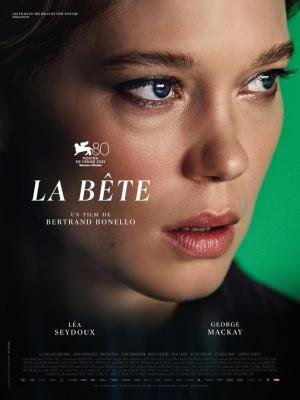The Beast(2023) Bertrand Bonello

Bertrand Bonello's cinema has always been characterized by being eclectic and often cryptic. They are not exactly easy works and, in this case at hand, The Beast is a very strange and difficult film to follow. But if we accept the director's challenge and let ourselves be carried away by his complex and meandering story, in the style of David Lynch in Lost Highway (1997) or Mulholland Drive (2001), we will realize that we are facing a great film that mixes the genres of science fiction and melodrama like few others. In The Beast, Gabrielle (Léa Seydoux) is a woman who wants to eliminate any trace of emotion from her DNA to get rid of unhappiness and improve her productivity. We are in a dehumanized future in which artificial intelligence dominates the world. For the process to have the desired result, Gabrielle will have to travel to her past lives located in 1910, 2014 and 2044. In them she will repeatedly encounter her impossible love, Louis (George MacKay), presented on all three occasions as a threat more than as the ideal of romantic love. The film will jump from one era to another looking for connections and echoes in the relationship of the two characters, destined for a tragic outcome. Perhaps the most conventional story here is the one set in 1910, in the Parisian belle époque, in which Gabrielle is a famous pianist who attracts the admiration and desire of the young Louis. She is married and the temptation of infidelity hovers over this part of the story at all times. In it we also find the most poetic and surreal sequence of the entire film when the water floods the factory in which the protagonists are located, thus ending all possibility of triumph for love. In 2014, the situation is radically different and here, Louis becomes the beast that gives the film its name, which then takes on a violent and unpleasant character. 2044 is, without a doubt, the most difficult part to follow due to its narrative complexity and may be the one that scares away the most viewers, confused by wanting to follow a coherent story.
Loosely, very loosely, based on the work of Henry James, The Beast in the Jungle, Bonello's film deals with many themes, some accurately, others not so much, but above all what predominates in it is love, understood as something to fear. The lead actors are fantastic. Léa Seydoux and George MacKay demonstrate exceptional chemistry, developing magnificent interpretive versatility in each of the periods in which the film takes place. The Beast is outstanding in terms of the meticulous aesthetic work with which Bonello treats the different times, a fact that speaks very well of the French director's ambitious visual proposal. The costumes, the makeup and hair, the artistic direction, all attention to detail to provide a contemporary dimension of what cinematographic art means. The music, the work of Bonello himself, gives the ensemble a defined hypnotic sensation very appropriate for what he is telling us. Perhaps what fails a little is the assembly. The 146 minutes of the film could have been reduced since it is true that some sequences can be considered mere filler.
Despite its great complexity and intricate narrative, The Beast is probably the most commercial thing Bonello has done to date. It contrasts greatly with the minimalism of his previous film, Coma (2022) and, although it is somewhat related, it is quite different from his most celebrated film, House of Tolerance (2011). But what cannot be denied is that The Beast will now occupy a prominent place in his filmography.
THANK YOU FOR FOLLOWING!!
All proceeds will be donated to reforestation projects of @El_Ente_Reforesta
For other donations:
https://elentereforesta.blogspot.com/?m=1
METAMASK
0x3a81DF00eE6c32661FA239cFDFde4A9473737C9C
Thank you!!
If you make a donation to this metamask, please indicate privately through which network you make it to count it.